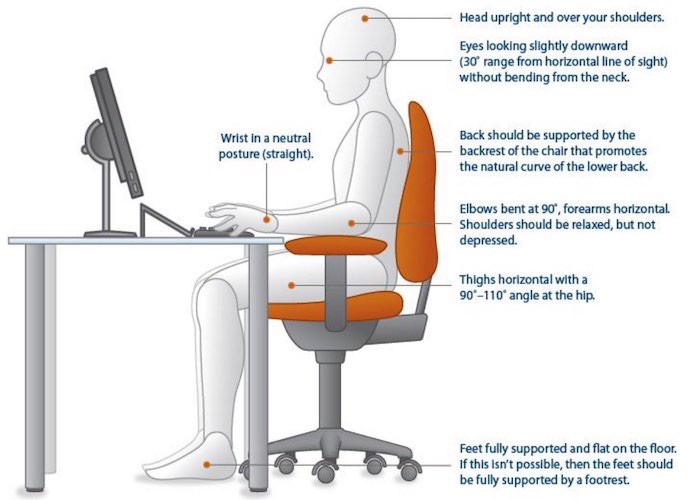5 tips for working at home – comfortably and productively
Posted on
by
Kirk McElhearn

Working remotely (i.e. working from home) has been gradually becoming more common. In recent weeks, global health concerns have rapidly accelerated this shift, and many people who have never worked from home before will be doing so for weeks or perhaps months to come. Some companies may even decide to continue to offer remote-work opportunities if they find that employees are just as productive working from home.
For many workers, this may not necessarily be an easy transition. As a telecommuter, you must consider a number of factors to make your workspace comfortable and efficient.
In this article, I’d like to share some tips based on my 25 years of working at home. I’ll cover how you can organize a space to work, how you can enhance your environment, and how you can pace yourself.
Set up your workspace
When working at home, the ideal situation is to have a dedicated room as your workspace. This may not always be possible; the best you may be able to do is work on a laptop in the kitchen. But if you can turn one room into your “home office,” this is preferable. The room doesn’t necessarily need to be available all day; you can probably put enough of your work material away to use the room in the evening, if it doubles as, for example, a playroom or living room.
The best solution is to have a desk or table and a good chair. If you normally work in an office but need to work at home for an extended period of time, find out whether you can bring your office chair home with you. A comfortable and supportive chair will be important if you’re seated for a long time.
Ergonomics are important: have your computer screen at the right height, and ensure there’s enough room to comfortably use a mouse and keyboard, if you use them. If you have other peripherals, such as a printer or scanner, you’ll need room for them as well. If you’re working on a laptop, you should try to use an external keyboard and mouse and raise the laptop so the top of the display is around eye height. You could get a stand, or even use a pile of books, but if you spend the day leaning over your computer, your neck and back will hurt. The U.S. National Institutes of Health has a self-assessment checklist (PDF link) that you can use as a guide to set up a sitting desk ergonomically.

Ergonomic recommendations for sitting at desks, via NIH (PDF).
For more tips about ergonomics, along with plenty of other advice about working from home, download a copy of the free e-book Take Control of Working from Home Temporarily, by my colleague Glenn Fleishman, who has also been working at home for many years.
Enhance your environment
Your desk and computer are one thing, but you should also think about your environment. Do you have a window, to provide sunlight and fresh air? If so, don’t put it directly behind your computer or behind you. If it’s behind your computer, it will be harder to see the screen; if it’s behind you, you’ll get reflections on the display. The best position is to have the window to one side.

Sunlight, fresh air, and plants can help enhance a home office environment. Photo: Olena Sergienko
It’s not yet summer in the northern hemisphere, but you may benefit from having a fan when it gets warm. Also, you should ensure that you’re not in a closed room for too long at a time. Multiple scientific studies have indicated that the increased carbon dioxide in enclosed spaces may reduce your cognitive abilities. Open windows when you can, and open the door to the room when you take breaks.
Get some plants, if possible, to make your environment more pleasant; not only are plants nice to look at, but there’s a nice symbiosis, as plants breathe CO2 and emit oxygen. And I find it useful to have music when I work; not all day, but at times when I need to focus, or when I want some inspiration.
Pace yourself
When you’re not accustomed to working at home, it may at first seem odd to miss out on some contextual signs of office life, such as in-person meetings, coffee or water cooler breaks, or eating with coworkers in the lunch room. Some people may find their home-work schedule structured by their employers, but not all. Because of this, you need to develop a routine.
 Don’t stay seated for too long: get up and walk around, ideally every half hour or so. You might want to try the Pomodoro Technique, where you work for 25 minutes, then take a five-minute break. You can get up, stretch, perhaps go outside, or get something to drink. Yes, drink plenty of fluids, but maybe not too much caffeine.
Don’t stay seated for too long: get up and walk around, ideally every half hour or so. You might want to try the Pomodoro Technique, where you work for 25 minutes, then take a five-minute break. You can get up, stretch, perhaps go outside, or get something to drink. Yes, drink plenty of fluids, but maybe not too much caffeine.
You’ll need to have some physical activity, especially if you’re no longer walking to the bus or train, or walking around near your office. If you run or cycle, you might still go out, local weather and other conditions permitting, but you can also try to find some inspiration on YouTube, where there are tons of videos about doing yoga and exercising at home.
Additionally, when some people work from home, they have a tendency to spend far more time working than is required of them. If your job expects you to work eight hours per day, keep tabs on the amount of time you’ve worked throughout each day, and make sure your eight hours doesn’t creep toward ten or twelve hours. Maintaining a proper work-life balance is important for your health.
Tools
Your employer will often choose your tools: hardware and software. None of this will likely be unfamiliar; you’ll probably use the same apps as usual, just, perhaps, on a different computer, tablet, or phone.
You might start using different messaging software, and you may use videoconferencing software as well, such as Skype, Zoom, Google Hangouts, or Slack. This type of software is a great way to keep in touch with colleagues; seeing their faces and hearing their voices will help you feel less isolated.
 If your employer expects you to use your own personal computer while working from home, you’ll want to use trusted endpoint protection software to actively protect your computer and block Microsoft Office macro viruses, ransomware, and other malware that may be more common in a business environment. Intego’s Mac Premium Bundle X9 is a very affordable, full-featured Mac protection suite that includes best-in-class protection against all types of malware (including viruses, ransomware, spyware, adware, and more), as well as a two-way firewall, and utilities for disk cleanup and file organization, backup, and parental controls.
If your employer expects you to use your own personal computer while working from home, you’ll want to use trusted endpoint protection software to actively protect your computer and block Microsoft Office macro viruses, ransomware, and other malware that may be more common in a business environment. Intego’s Mac Premium Bundle X9 is a very affordable, full-featured Mac protection suite that includes best-in-class protection against all types of malware (including viruses, ransomware, spyware, adware, and more), as well as a two-way firewall, and utilities for disk cleanup and file organization, backup, and parental controls.
![]() Some companies have a corporate virtual private network (VPN) solution that allows you to connect your computer to the office network. If your company doesn’t provide access to its own VPN, you may want to consider using a personal VPN to protect your privacy (for example, if you use an e-mail application such as Apple’s Mail app or Microsoft Outlook, your home IP address will be sent to everyone you e-mail and every site you visit, unless you use a VPN). Both corporate and personal VPNs can also protect your communications when you’re away from home and using someone else’s Wi-Fi network, where it may be easy for others to spy on your activities.
Some companies have a corporate virtual private network (VPN) solution that allows you to connect your computer to the office network. If your company doesn’t provide access to its own VPN, you may want to consider using a personal VPN to protect your privacy (for example, if you use an e-mail application such as Apple’s Mail app or Microsoft Outlook, your home IP address will be sent to everyone you e-mail and every site you visit, unless you use a VPN). Both corporate and personal VPNs can also protect your communications when you’re away from home and using someone else’s Wi-Fi network, where it may be easy for others to spy on your activities.
Since all of your Internet traffic will pass through a VPN, it’s critical to only use a VPN provider you know you can trust. Intego Privacy Protection is a trusted VPN—at a very affordable price—that offers powerful protection for your Mac or Windows PC. If you need protection for both your computer and also your iPhone or Android phone, you can alternatively choose from a trusted VPN provider like Private Internet Access, ExpressVPN, or CyberGhost.
Parenting

One of the biggest difficulties for home workers with children will be parenting, especially if schools and daycare centers are closed. It won’t be easy to juggle your work while keeping your kids occupied. If your household has two parents, it’s a good idea to schedule your days so one parent is available often, especially with younger children. With some jobs, your work hours may be flexible, so if you don’t have to work nine to five, this could make things easier.
And remember that you no longer have any commuting time, which means that you have, perhaps, one or even two hours more than when you went into the office. Use this time to allow yourself a bit of space and be present for your kids.
What else should I know about working from home?
The transition to working from home may be difficult for many people who have never done so before. Take some time to think about how you can make the most comfortable environment, and pace yourself.
Getting fresh air, taking frequent short breaks, conversing with others via video or voice calls, maintaining a proper work-life balance, and thinking positively can all help you stay both physically and mentally healthy.
And on that last note, if you find yourself feeling depressed during your transition to working from home, seek guidance from a mental health professional.
How can I learn more?
My co-host Josh Long and I discussed our personal experiences with working from home on episode 127 of the Intego Mac Podcast. Be sure to give it a listen!
You can also download the free e-book Take Control of Working from Home Temporarily, by Glenn Fleishman, for additional insights and tips.
 Each week on the Intego Mac Podcast, Intego’s Mac security experts discuss the latest Apple news, including security and privacy stories, and offer practical advice on getting the most out of your Apple devices. Be sure to follow the podcast to make sure you don’t miss any episodes.
Each week on the Intego Mac Podcast, Intego’s Mac security experts discuss the latest Apple news, including security and privacy stories, and offer practical advice on getting the most out of your Apple devices. Be sure to follow the podcast to make sure you don’t miss any episodes.
You can also subscribe to our e-mail newsletter and keep an eye here on The Mac Security Blog for the latest Apple security and privacy news. And don’t forget to follow Intego on your favorite social media channels: ![]()
![]()
![]()
![]()
![]()
![]()
![]()
Photo credits: “Pomodoro Technique (Illustration)” tomato-shaped egg timer photograph by Michael Mayer, licensed under CC BY 2.0. “Mothers Working From Home – Credit to https://www.lyncconf.com/” photograph by LyncConf; license: CC BY 2.0.